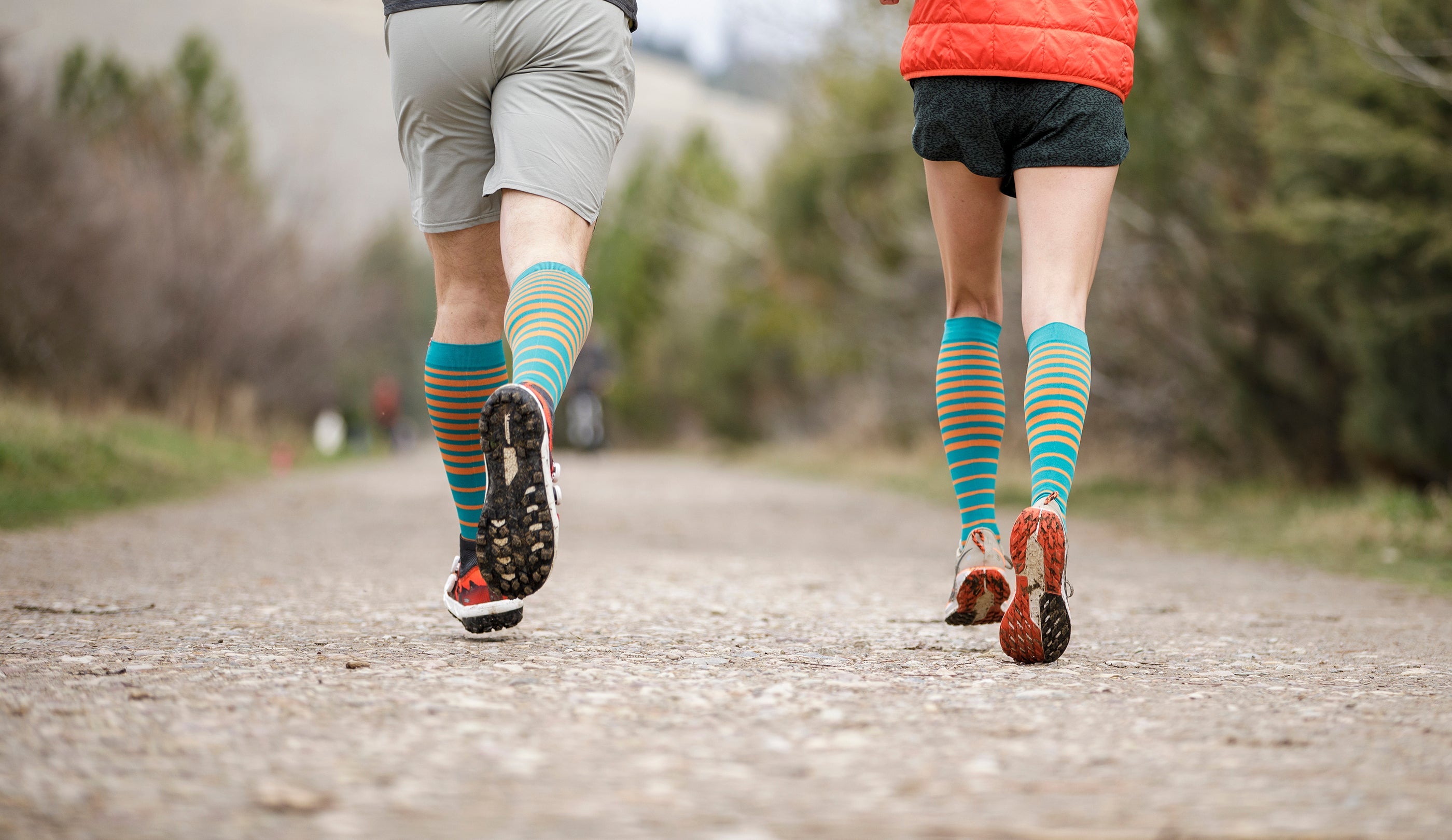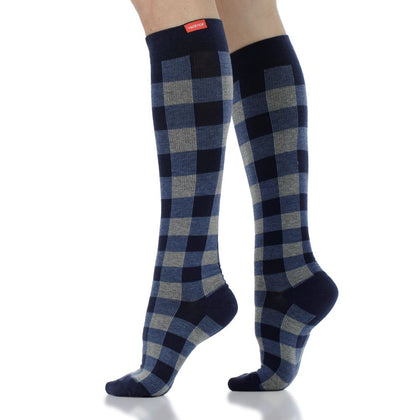

When working to manage your diabetes, your symptoms are more than just high blood sugar. An important way that diabetes changes your lifestyle is how it can impact blood circulation and the sensations in your extremities.
Because diabetes is known to complicate circulation, compression therapy can be a powerful tool to manage diabetes symptoms and improve comfort and wellbeing, especially in your legs. In this article, we’ll explore how compression socks for diabetes can deliver multiple benefits, from improved blood flow to lower leg pain, discomfort, and the risk of complications.
Note: compression socks are not a medical advice, and you should consult with your doctor if you are unsure if compression socks are right for you.

Start feeling better in style: explore our diabetic compression socks designed for all-day comfort and support.
What Do Compression Socks Do for People with Diabetes?
Many people working to manage diabetes experience swelling and discomfort in the lower legs or poor peripheral circulation. Edema is a common problem for people with diabetes. Edema, when fluid accumulates in the bodies tissues, has been successfully reduced swelling as shown in studies like this one, using mild compression therapy.
Diabetes compression socks offer benefits like improved blood circulation, less swelling and discomfort, and support to the muscles and joints, all without affecting your blood flow. This is a concern when patients also suffer from peripheral arterial disease, which is common in people with diabetes. Medical research has found that compression socks are safe for people with diabetes.
How Diabetes Impacts Circulation and How Compression Supports Blood Flow
Diabetes is a medical condition where a person’s blood sugar (glucose) is too high for long periods of time. Glucose from the blood is what gives the cells in your body energy through the help of a hormone known as insulin.
There are multiple types of diabetes:
- Type 1 diabetes often occurs early in life and is distinguished by the indicator that the person’s pancreas doesn’t produce enough insulin.
- Gestational diabetes occurs in pregnant women and manifests itself by high levels of blood glucose, which can affect the health of both the mother and the developing fetus.
- Type 2 diabetes occurs when a person’s body is unable to use insulin effectively.
Too much sugar in the bloodstream is the hallmark of diabetes. Over time, this can cause arteries to become narrower, stiffer, and/or inflamed. This can cause problems with blood circulation and increase your risk of stroke.
Moreover, around 1 in 3 people with diabetes over the age of 50 are at risk of developing peripheral arterial disease (PAD). This condition occurs when the blood vessels in the legs become narrower because of fat deposits in the arteries, also known as atherosclerosis. As a result, blood flow to the feet and legs can be lower than needed. This may lead to numb feet, tingling, feeling cold, and other discomforts and risks.
To help people with diabetes, compression socks can improve circulation and reduce symptoms like swelling, discomfort, and tingling, and numbness. They are often used to help reduce the risk of blood clots, but also to help manage diabetic ulcers, among other conditions. Research has found that mild-compression diabetic socks can effectively help improve lower leg edema, which can enhance the quality of life of people working to manage diabetes.
Benefits of Compression Socks for Diabetes
Improved blood flow is the key benefit of wearing diabetes compression socks. Through the therapeutic pressure exerted by compression socks, lower leg blood flow is enhanced to help improve diabetic edema, pain, discomfort, and tingling or numbness. Moreover, compression socks can reduce your risk of blood clots, and they are easy to wear and even a stylish addition to your wardrobe.
Enhanced Blood Circulation
The key benefit of wearing compression socks, especially graduated ones, is that they boost blood flow to the lower legs. Graduated compression socks are tighter at the ankle and ease up as they travel towards the knee. This stimulates blood flow towards the heart and back into the circulatory system. For people with diabetes, who often struggle with peripheral circulation, stimulating circulation can be a game changer in terms of improving comfort and preventing other complications.
As a result of improved circulation, there’s less swelling and pain in the legs. Better blood flow also helps diabetics recover more easily and quickly from physical exercise. Crucially, this reduces many risks of associated medical conditions, from blood clots to DVT (deep vein thrombosis) and more.
Reduced Swelling and Edema
One of the added benefits of compression therapy is that the boost in blood flow works to reduce swelling in the legs and feet. When capillaries (small blood vessels) leak fluid, it can pool in your tissues to cause edema. Instead of having swollen, puffy feet and legs, wearing compression socks ensures a constant gentle pressure is applied to the legs. This supports blood flow through capillaries and pushes excess fluid out of the surrounding tissues.
Minimized Risk of Blood Clots
A well-functioning circulatory system reduces the risk of blockages in the veins, which can lead to the formation of blood clots. Wearing compression socks may reduce risks associated with damaged veins that diabetes may have caused. Thanks to compression socks stimulating blood flow through these veins, you’re may be less likely to suffer from life-threatening complications such as blood clots.
Alleviation of Leg Discomfort and Pain
Swollen legs and feet often lead to pain and discomfort. Diabetes can cause many challenges with your everyday comfort, you’re likely to get numb or tingling feet from bad circulation. The build-up of blood and fluid in the lower limbs can be feel painful and uncomfortable.
Compression socks help with this in two ways. First, continuing to support blood flow means that the fluid build-up in the tissues is less likely to occur. Second, if you have swollen legs and feet, wearing compression garments will massage the fluid out, reducing the discomfort through gentle pressure. It will also stimulate blood flow to those areas, helping the swelling, inflammation, and associated pain levels decrease.

Looking for diabetic-friendly features like wide calves, soft seams, and breathable fabric? Shop our diabetic compression socks collection.
Do Compression Socks Work for Diabetic Neuropathy?
Diabetic neuropathy is a type of nerve damage caused by high blood sugar levels over time. It often affects the feet and legs, leading to numbness, tingling, pain, or weakness. These symptoms can increase the risk of injuries and make everyday activities - like walking or exercising - more challenging.
Wearing compression socks for diabetes may help manage some of these symptoms by improving circulation and supporting overall foot and lower leg health. More research is needed, but with the information available, research shows that compression socks may help with symptoms of diabetic neuropathy. Here’s how they can help:
- Boost blood flow: Graduated compression gently squeezes the legs, encouraging circulation. Better blood flow helps keep the feet warmer and may ease tingling or numbness.
- Reduce swelling (edema): People with diabetes often experience fluid buildup in the legs. Compression socks can lower this risk and improve comfort.
- Support the ankle joint: The snug fit provides extra stability, which can improve balance and confidence when walking or exercising.
- Soothe muscles: Gentle compression creates a massaging effect that can reduce discomfort and fatigue in the lower legs.
- Protect the feet: Quality compression socks add a layer of defense against cuts, grazes, and friction, while also providing extra padding for daily comfort. According to Johns Hopkins Medicine, the feet are a particularly at-risk part of the body for people with diabetes.
However, please be careful. Not all people with diabetes should wear compression socks. If you have peripheral arterial disease (PAD), severe neuropathy, diabetic ulcers, or open wounds, consult your doctor before use. A healthcare professional can recommend the right compression level (often 15-20 mmHg for daily wear) based on your needs.
How Often Should a Person with Diabetes Wear Compression Socks?
Although there is no specific restriction on how long or how often you should wear compression socks for diabetes, this varies depending on your condition and on your personal preferences.
We recommend trying compression socks for a few hours at a time when you’re wearing them for the first time. See how you feel and increase your time wearing them gradually. You can wear your socks all day long, and it’s recommended that you take them off before going to bed.
Should Diabetics Wear Compression Socks to Bed?
Wearing compression socks while sleeping is not always recommended, and the decision should be made with guidance from a healthcare professional. While there is no inherent danger for many people, those with diabetes and related complications need to be especially careful.
Here are some considerations for nighttime use of diabetes compression socks:
- Circulation concerns: When you lie down, your blood flow patterns may change, so you should check with your doctor if you should alter the compression level of your socks when you sleep.
- Cold feet relief: A side effect of reduced blood flow or nerve damage caused by diabetes, cold feet can be soothed by compression socks thanks to how they stimulate blood flow. Additionally, soft and warm merino wool socks are known for their thermoregulating properties - keeping your feet warm and dry in cooler environments.
- Compression levels matter: Higher-pressure socks (20–30 mmHg or above) are generally not advised for overnight wear unless specifically prescribed. If nighttime use is recommended by your doctor, mild compression (15–20 mmHg) is typically the safest option.
Choosing Diabetic Compression Socks
To make the most of your diabetic compression socks, you should be aware of a few factors that influence how well they’ll work for you. This includes fabrics, finding the right fit, and compression levels.
Seamless Toes, Breathable Fabrics, and Soft Cuffs
The fabric of your compression socks for diabetes influences your comfort. Here are the Vim & Vigr compression sock choices we recommend for different weather conditions and activity levels:
- Cotton is great for everyday wear, being soft and stretchy, but not too thick; however, it is not great at wicking away moisture, so we would recommend wearing it for work, relaxing, or sleeping, but not for physical activity.
- Moisture-wicking nylon and merino wool are the best options if you want to wear your socks while practicing a sport; they keep your feet dry and wick away sweat, while preventing the buildup of bacteria that cause unpleasant odors.
- Merino wool is also known for its thermoregulating and antibacterial properties. We recommend merino wool compression socks for hiking, walking, or keeping feet warm and dry in cold weather. Moreover, this fabric is great for protecting the lower legs from cuts and scrapes and preventing infections (a concern for many diabetic patients).
- Nylon compression socks are sleek and flexible, moving seamlessly with your body. We’ve also created a special seamless toe edition of these to remove any risk of blisters or rubbing.
Finding the Right Fit (Including Wide-Calf Options)
To enjoy the benefits of compression, it’s important to have socks that fit well, applying pressure to stimulate blood flow, but not so tightly that they become uncomfortable. This is why we recommend starting with our sizing chart to find the best fit: measure your calf circumference and map that against your shoe size to get your compression socks size.
If you have a wider calf, Vim & Vigr compression socks come in a separate size to ensure you’re comfortable but still get the therapeutic benefits. Any calf circumference over 16 inches will fit in here.

Understanding Compression Levels
The final piece of the compression sock puzzle is choosing the right level of pressure applied to your lower legs. Not all socks are the same and, depending on your medical condition, you’ll want to check which pressure levels work best for you. Compression sock pressure levels are measured in mmHg and generally fit under three categories:
- 15-20 mmHg is the casual, everyday wear level, suitable for beginners and for long-term wear or for wearing when you sleep (assuming this has been confirmed safe by your doctor).
- 20-30 mmHg socks are firm and apply more pressure, being more suitable for those with a circulatory condition (such as blood clots or varicose veins) - consult with a medical professional to see if these are right for you.
- 30-40 mmHg is a medical, prescription-only compression level which your doctor could recommend when you’re bedridden or recovering from surgery, or in specific cases dictated by your medical condition.
At all compression levels, Vim & Vigr socks are stylish, colorful, and extremely versatile. They can fit just as well within a monochrome office wardrobe or as part of a more playful, casual outfit. And no one will necessarily know they are compression socks, either!
Wearing Compression Safely with Diabetes
While compression socks can be very beneficial for people with diabetes, it is important to use them correctly to avoid unwanted side effects. Here are some tips to keep in mind:
- Avoid overnight use unless prescribed or checked with a doctor. If you want to keep your feet warm or have some extra protection when you sleep, choose diabetic socks instead.
- Ensure you’re wearing the right fit. Compression socks should feel snug, but never painfully tight. A proper fit ensures they support circulation without restricting blood flow. If you’re new to compression, start with 15–20 mmHg graduated compression, which is safe for daily use.
- If you suffer from sores or have any open cuts, avoid wearing compression socks until these have healed. Equally, don’t put on compression socks immediately after using a treatment lotion on the skin (they will absorb it and can get damaged, while reducing its action on the area being treated).
- If you have cuts or sores on your toes, choose open-toed compression socks so you can inspect them easily and let them breathe.
Always consult your healthcare provider before making compression socks part of your daily diabetes care routine.
–
Thanks to how they support lower leg circulation, reducing swelling and discomfort and supporting the joints and muscles, graduated compression socks are a useful tool to improve overall wellbeing when you suffer from diabetes. However, you should always check with your doctor to ensure they are safe to wear in your condition and to get guidance about how best to wear them.

Ready for compression that works and looks good doing it? Browse our diabetic compression socks and find your perfect pair.
References
Charles, T., Mackintosh, D., Healy, B., Perrin, K., Weatherall, M., & Beasley, R. (2011). Merino wool graduated compression stocking increases lower limb venous blood flow: a randomized controlled trial. Advances in therapy, 28(3), 227–237. Read it here.
Cleveland Clinic. (2024). Insulin. Read it here.
Compression Therapy in Diabetic Foot Ulcer Management: A Review of Clinical Effectiveness, Cost-effectiveness and Guidelines [Internet]. Ottawa (ON): Canadian Agency for Drugs and Technologies in Health; 2014 Oct 15. Read it here.
Johns Hopkins Medicine. (n.d.). Foot Care for People with Diabetes. Read it here.
Mayo Clinic Staff. (2024). Diseases & Conditions: Peripheral artery disease. Mayo Clinic Press. Read it here.
Mayo Clinic Staff. (2025). Diseases & Conditions: Type 2 diabetes. Mayo Clinic Press. Read it here.
Partsch, H., Winiger, J., & Lun, B. (2004). Compression stockings reduce occupational leg swelling. Dermatologic surgery: official publication for American Society for Dermatologic Surgery [et al.], 30(5), 737–743. Read it here.
Rother, U., Grussler, A., Griesbach, C., Almasi-Sperling, V., Lang, W., & Meyer, A. (2020). Safety of medical compression stockings in patients with diabetes mellitus or peripheral arterial disease. BMJ open diabetes research & care, 8(1), e001316. Read it here.
Sachdeva, A., Dalton, M., & Lees, T. (2018). Graduated compression stockings for prevention of deep vein thrombosis. The Cochrane database of systematic reviews, 11(11), CD001484. Read it here.
Yachmaneni, A., Jr, Jajoo, S., Mahakalkar, C., Kshirsagar, S., & Dhole, S. (2023). A Comprehensive Review of the Vascular Consequences of Diabetes in the Lower Extremities: Current Approaches to Management and Evaluation of Clinical Outcomes. Cureus, 15(10), e47525. Read it here.
Wu, S. C., Crews, R. T., Najafi, B., Slone-Rivera, N., Minder, J. L., & Andersen, C. A. (2012). Safety and efficacy of mild compression (18-25 mm Hg) therapy in patients with diabetes and lower extremity edema. Journal of diabetes science and technology, 6(3), 641–647. Read it here.
Wu, S. C., Crews, R. T., Skratsky, M., Overstreet, J., Yalla, S. V., Winder, M., Ortiz, J., & Andersen, C. A. (2017). Control of lower extremity edema in patients with diabetes: Double blind randomized controlled trial assessing the efficacy of mild compression diabetic socks. Diabetes research and clinical practice, 127, 35–43. Read it here.











